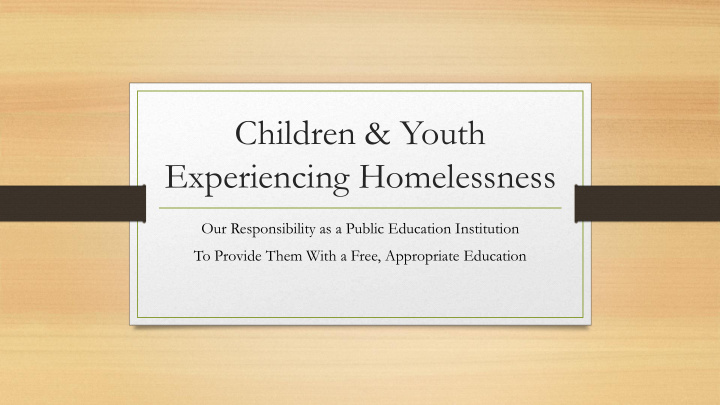



Children & Youth Experiencing Homelessness Our Responsibility as a Public Education Institution To Provide Them With a Free, Appropriate Education
The Scale of Homelessness Children make up half of the homeless population nationwide In 2014-15 there were 1,360,747 homeless children enrolled in public schools (National Center for Homeless Education) Do you know how close homelessness is to you?
How vulnerable are YOU to becoming homeless? Fire Flood Job Loss Eviction Domestic Violence Accident Illness
McKinney-Vento Homeless Act, amended by Every Student Succeeds Act (ESSA) New Legislation passed effective 10/1/16 Requires educational access, attendance, and success for children and youth experiencing homelessness. Provides states with funding to support statewide initiatives
Who is Homeless? An individual who lacks a fixed, regular and adequate nighttime residence Includes children and youth who are: Sharing housing Living in motels, hotels, cars, campgrounds, parks, abandoned buildings Living in emergency or transitional housing Unaccompanied Youth – abandoned, runaways Migratory children (living in circumstances above)
Homeless Children Characteristics Some common statements used by homeless students include: • Attendance at several schools • “We’ve moved a lot.” • More than one family at the same address • “We’re staying with friends.” • Attention-seeking behavior • “We’re looking for a place.” • Hunger and hoarding of food • “We’re going through a bad time • Sleeping in class now.” • Inappropriate dress for weather
Unaccompanied Youth Any child who is not in the physical custody of a parent or legal guardian Includes runaways, children thrown out of their home, children who have been abandoned by parents or separated from parents for any other reason
Enrollment in School Public schools must immediately enroll students experiencing homelessness even when lacking: Proof of residency Guardianship Birth certificates, school records, or other documents Medical records, including immunization records Child is eligible to attend school of origin, regardless of temporary residency, if the parent/child wishes and it is in the child’s best interest
Transportation School districts are required to adopt practices to ensure that transportation is provided to school of origin, often working with other districts. They are responsible for revising policies that may act as a barrier for homeless students to access expedited transportation services. School of origin is defined as the school the child attended when permanently housed or where they were last enrolled. If the child is unaccompanied, his/her wishes should be taken into consideration. Child’s right to attend their school of origin extends for the duration of their homelessness. Effective 10/1/16 , if the child becomes permanently housed in another district, they are entitled to continue enrollment and transportation services to their school of origin for the remainder of the school year. Title I monies can be used to transport a homeless student or former homeless student.
Extracurricular Activities Districts must implement procedures to ensure that homeless students/unaccompanied youth do not face barriers to accessing academic and extracurricular activities, including after-school and summer programs. Outstanding fees and fines must not present barriers to these students.
Title I, Part A Set-aside funds Can be used for: clothing, shoes, school supplies, eye glasses, or hearing aids, student fees that are necessary to participate in the general education program and college application or entrance fees Can be used for immunizations, food, medical, and dental services, counseling or outreach services Can be used for transportation costs (gas cards, bus passes) TITLE I FUNDS CANNOT BE USED FOR RENT, UTILITIES, OR CLOTHING FOR PARENTS.
What can WE do? Make the student feel welcome Try to make contact with the parents and invite them to participate in school activities Be sensitive to needs of homeless children, but maintain consistent, high expectations Try not to take away possessions or Physical Education as a disciplinary measure Be aware that some assignments/projects may be difficult for the student (internet access) Ensure opportunities to participate in after-school activities and in-school programs
Identification of Homeless Students/Unaccompanied Youth Teacher finds out that student is homeless - Notify guidance counselor, building principal, Supervisor of Special Education (if appropriate) Notify district homeless liaison, Mrs. Pam Janda, who will contact parent/guardian to advise them of their rights and try to answer questions if they have any, initiate intake form, contact BCIU, contact Food Services Manager to ensure student is receiving free breakfast & lunch, and work with transportation director to initiate transportation if needed.
“I was homeless and I was in San Diego and I started singing in a coffee shop and people started coming to hear me sing.” ~ Jewel Any Questions???
Recommend
More recommend